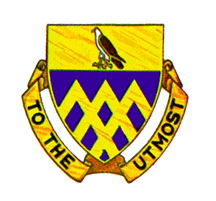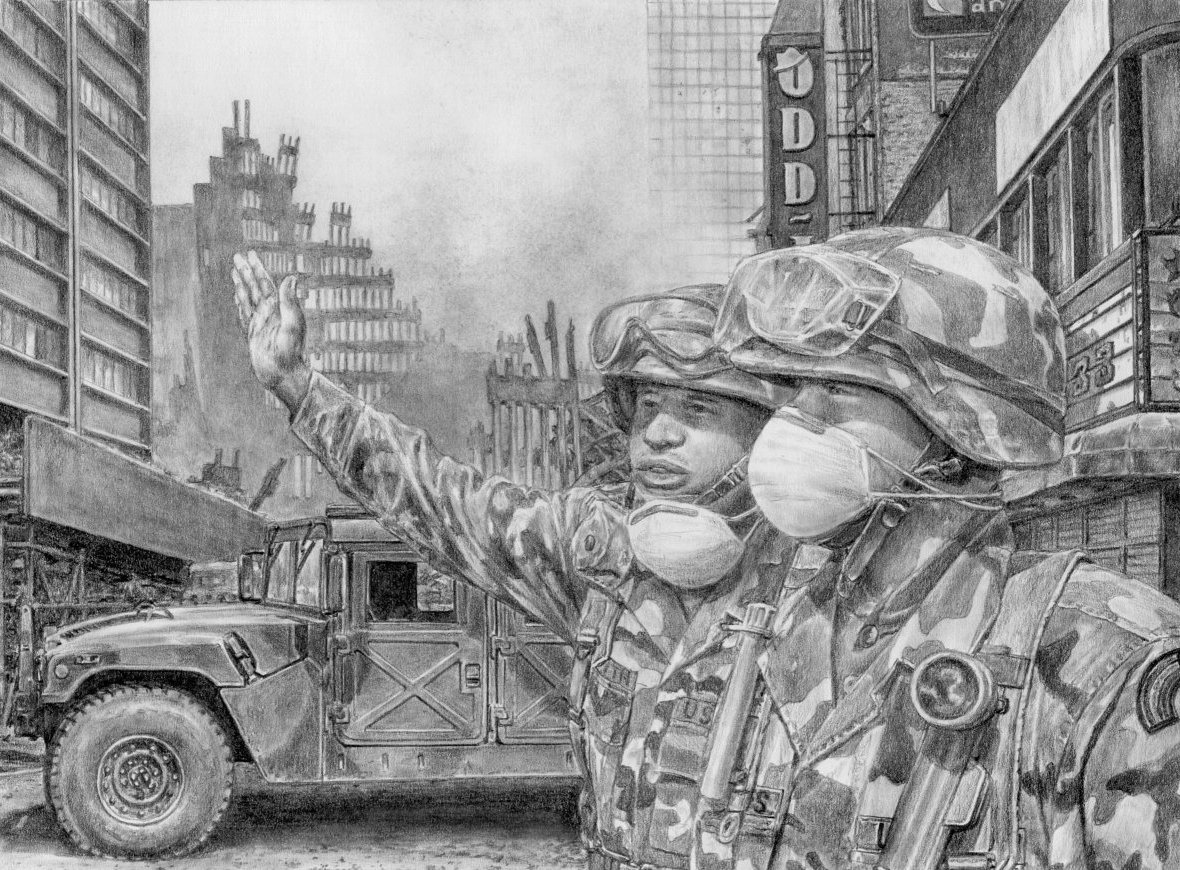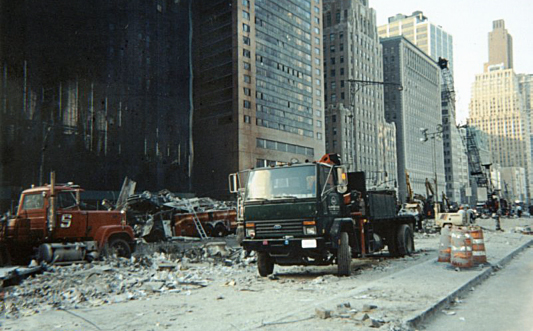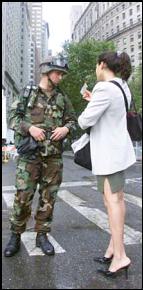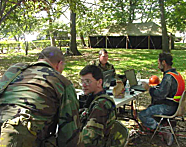ANSWERING THE 9-11 CALL
CPT Dave
Willis, S1 of the New York Army National Guard’s 1st Battalion, 101st Cavalry
(Tank), was no stranger to the small park outside 1 Liberty Plaza near
Manhattan’s southern tip. Nestled near the base of the 110-floor Twin Towers of
the World Trade Center it was a place to sit, catch some sun, and watch pretty
girls go by. But at 1700 on September 11, 2001, the scene was quite different as Willis and 25 members of the 1-101st Cav rushed into Manhattan from the unit’s Staten Island armory. This once familiar site now looked like a scene from hell.
Everything was covered with thick dust, the pulverized residue of concrete, gypsum, asbestos, charred wire, and human remains. Dense, acrid smoke filled the air, stung the eyes, choked the lungs, and blocked out the sun. Hundreds of firefighters, looking desperately for survivors, swarmed over what remained of two of the tallest buildings in the world. “It was hard to make out exactly how much damage there was through all the smoke,” Willis remembered. “We could only see one corner of World Trade Four. It was smashed flat. Tower Two had landed on it. “The feeling on the ground was more or less total chaos. It took me 15 minutes to find somebody who could even claim to be in charge,” he recalled. With two ambulances, a truck full of medical supplies and 25 medics and tankers, the detail was the 1-101st Cav’s first response to the most devastating attack ever launched on the United States. Equipped with basic M1 tanks, the “Wingfoot” battalion’s primary focus had always been tank gunnery and maneuver training. OOTW and urban civil assistance operations had not been a training priority, although the battalion had been called to state active duty for almost two weeks during a devastating ice storm in January 1998. Using the battalion’s Staten Island armory as home base, over 400 members of the battalion spent two weeks aiding the New York City Police and Fire Departments. It was one of several New York National Guard units called into action for the emergency. The unit’s soldiers provided aid to displaced civilians, secured the disaster site itself, shut down unnecessary traffic in southern Manhattan, transported needed supplies, and provided a military presence that reassured city residents. The unit is configured as a standard armor battalion. HHC and A Company are headquartered on Staten Island, a short ferry ride across New York Harbor from the World Trade Center (WTC) site, while other subunits are based farther north in Upstate New York. B Company is based in Troy, 170 miles away; C Company in Hoosick Falls, 200 miles away, and D Company has its headquarters in Newburgh, 81 miles up the Hudson River from Staten Island. 1-101st Cav soldiers began reacting to the WTC attack even before it was clear what had happened. As broadcasts reported that a plane had hit one of the Twin Towers, battalion members began calling to let the full-timers know where they could be reached. Soon they were heading for their armories, anticipating New York State Governor George E. Pataki’s general mobilization of the New York National Guard. HHC and A Company, closest to the disaster, mobilized to provide relief immediately. A local Home Depot store offered to donate supplies and the battalion dispatched a HEMTT to pick up picks, shovels, lights, generators, and other useful items. The battalion also responded to an urgent request from medical officials and gathered 100 body bags for delivery to an aid station hurriedly set up at a Staten Island baseball stadium. The situation on Manhattan was unclear. The collapse of the Twin Towers wiped out both the key leadership of the New York Fire Department and the city’s emergency management team. The New York City telephone system had broken down because key phone relays and cell phone transmitters were destroyed in the attack. At the same time, the crippled system was overloaded with calls. Unable to contact state headquarters in the Albany area, LTC Mario Costagliola, battalion commander, and the commanders of the other two Army National Guard combat units in New York City — the 1st Battalion, 69th Infantry, and the 1st Battalion, 258th Field Artillery — approached the police and put together an ad hoc plan to secure southern Manhattan. The three commanders agreed the 1-69th Inf and 1-101st Cav would establish a security perimeter south of Canal Street, and be relieved by 1-258th FA that night. While their New York City brothers in arms were responding to urgent calls for help, the soldiers of B, C, and D Companies rallied at their armories and began loading trucks for the move south. Communications with Staten Island were virtually nil, so the XO assumed control of the upstate units and directed C Company, the most remote unit, to move its soldiers and equipment to Troy as quickly as possible. The goal was to muster B and C Companies together and road march south to Staten Island. Contact was finally made with LTC Costagliola, who directed D Company to move to Staten Island on the New York State Thruway no later than 2000 and instructed the XO and CSM to move B and C as quickly as possible. With only about 200 soldiers at the Staten Island Armory, the 1-101 Cav needed its upstate manpower to complete the mission. But the B Company and C Company move was delayed. State headquarters refused to issue road clearance for a convoy, or to provide a bus for soldiers who couldn’t be carried in military vehicles. The response to the XO’s entreaties to move the two companies was that there was no mission request yet. Complicating the movement request was the fact that the New York National Guard’s standing disaster relief C2 arrangements put A, D, and HHC, 1-101st Cav subordinate to NYARNG’s 53rd Troop Command, while B Company and C Company fell under the geographic region controlled by HQ, 42nd Infantry Division. Direct intervention by the 53rd Troop Command commander finally eliminated the logjam at state headquarters, but by then it was too late to move B Company and C Company that night. On the morning of September 12, the soldiers of A and D Companies and HHC deployed to Manhattan with the armored HMMWVs of the combined scout/mortar platoon, dubbed Saber Element, leading the way. As he came within sight of the devastated buildings, LTC Costagliola could think only of nuclear winter. Lower Manhattan looked like an atomic bomb had gone off, he recalled. The streets were littered with abandoned cars, many with roofs crushed by chunks of concrete. Scraps of paper littered the ground, and thick gray dust covered everything. Above it all hovered the heavy pall of smoke from the World Trade Center.
Uncertain about what missions they faced, the battalion brought empty trucks, a HEMTT loaded with emergency supplies, wreckers, fuelers, and weapons and riot control equipment stored on locked, built-up five-tons. The fresh soldiers linked up with a 30-member element that 1LT Tracey Young, commander of A Company, had brought to Manhattan on the night of September 11 to relieve CPT Willis’ contingent. The 1-69th Infantry and 1-101st Cav established a line of troops that effectively closed Manhattan Island south of Canal Street and placed assembly areas in Battery Park, at Manhattan’s southern tip. Battery Park is usually where tourists line up to buy tickets for trips to the Statute of Liberty. The Park included historic Castle Clinton, built as a harbor fortification in 1808. During the Civil War, New York troops mustered there. Once again it was a military assembly area. While A, D, and HHC took their positions, B and C Companies were road marching south to link up with the rest of the battalion in Manhattan. The upstate New York soldiers were routed around traffic by the New Jersey State Police and their 20-vehicle convoy was rolling along a deserted highway leading to the Holland Tunnel and Manhattan by 1000. As they approached, they caught glimpses of the gaping hole in the New York City skyline, replaced by a huge, rising cloud of smoke, which was evident for miles away. The battalion’s main mission was to help the New York City Police Department keep gawkers and other non-essential personnel out of Lower Manhattan. With more manpower, 1-69th Infantry took the larger perimeter stretching along the west side of Manhattan up to Chambers Street. Broadway was the operational boundary between the two battalions. Each company was assigned a piece of the screen line. Three to five soldiers, backed up by NYPD members, checked identifications and determined who could enter the so-called “frozen zone.” Among them were the residents who lived in that area. Companies provided soldiers to escort southern Manhattan’s apartment dwellers, hurriedly evacuated on September 11, into and out of their homes as they searched for pets, prescriptions, and valuables. The soldiers often provided a comforting shoulder when residents broke down, confronted by the devastation around them. 1-101 Cav also assumed initial responsibility for securing and providing staffing for one of the emergency morgues set up in 1 Liberty Plaza, a massive office building which many rescue workers feared would fall. The battalion’s support platoon and maintenance platoon provided details to keep nonessential personnel and the curious from interfering with the battalion medics working inside. Work on the site was punctuated by periodic warnings that buildings were about to collapse. Everybody quickly learned that three blasts on an air horn meant “Run like hell... something’s coming down.” There were several false alarms, and by Day Three of the operation, it was SOP that rally points be established for soldiers working near the WTC site and that by-name lists of soldiers on details had to be provided to the TOC for accountability purposes. Battalion soldiers also conducted a variety of logistics missions. Battalion trucks carried bottled water and jackhammers from a ferry landing on the Hudson River to the WTC site and provided a water buffalo for FBI agents screening WTC refuse at the Staten Island landfill. The fire department on Staten Island was provided with an M-1064 mortar track to use in blocking an entrance into a critical area, and HEMTT fuelers were stationed on Manhattan to fuel Fire Department vehicles. Battalion HMMWVs were also used to collect and distribute food prepared by restaurants to feed rescue workers. Many of the cav unit’s soldiers were frustrated because they wanted to go to the WTC site and help dig out survivors. It galled them to read accounts of volunteers from Maine or Ohio who were allowed to work at the site. Many 1-101 Cav soldiers felt a special urgency to help in the rescue effort because the New York City-based members had friends buried in the rubble. Almost a quarter of the battalion’s soldiers are police officers and firefighters. They felt the loss of colleagues killed when the buildings collapsed. But the situation at Ground Zero demanded special expertise in recovery that the battalion’s soldiers didn’t have. The Fire Department insisted that the Guardsmen could do more good in a security mission. That was borne out on the night of September 13 when the battalion was asked to come in and perform a crowd control mission at the site. A massive crane was being erected and the hosts of firemen and police officers on hand to watch and help were getting in the way. At the request of the fire department, the battalion’s A and D Companies came in to clear the way and then established an inner perimeter to keep nonessential, but well-meaning, personnel away. As a “third party,” the Guard had authority that neither the cops nor firefighters would have had with each other. The Guard presence also put an end to a lot of well meaning but unnecessary rescue workers freelancing at the site. With so many unit members in the NYPD or the FDNY, about 100 opted to serve with those city organizations when the 1-101st mobilized. Fortunately, many key leaders and soldiers in critical positions, like HHC commander CPT James Hom, and A Company commander 1LT Tracey Young, members of the NYPD, opted to mobilize with the unit. He mobilized with the 1-101st, 1LT Dennis O’Brien (also a lieutenant in the NYPD) explained, because he felt he could do more good as a Guardsman than as a police officer. O’Brien said that as a police lieutenant, he would show up at a station house and be handed a list of paper with the names of three sergeants and 12 officers he’d never worked with before and told to head out to Manhattan. By serving with the 1-101st Cav, he was working with people he knew and who knew him, and with a defined chain of command, he said. The battalion operation quickly assumed the familiar framework of tactical echelons. The Manor Road Armory on Staten Island served as the field trains and life support center. A maintenance slice worked here to keep vehicles running and handle logistics reports and paperwork, while the battalion’s mess section served meals before shifts and ran lunchtime LOGPAC to troops working in Manhattan. The battalion S4 immediately opened a contract with a local caterer and arranged for laundry services. The S4 section also coordinated the distribution of bottled water, extra food, and clothing and toiletry items donated to the rescue effort by local businesses. A small slice of HHC soldiers, supplemented by members of the New York Guard, a voluntary state militia organization, provided armory security and ran some logistics support missions from the armory. The soldiers from B, C, and D Companies were housed in the armory mess hall and classroom while HHC and A Company soldiers crammed themselves into offices. Soldiers who lived on Staten Island were allowed to go home to make space in the building. Transportation was arranged through the Metropolitan Transit Authority, which provided buses to move the soldiers to and from Manhattan. An emergency-vehicle lane on the Brooklyn Expressway and Staten Island Expressway provide access to Manhattan through the Battery Tunnel. The battalion also made extensive use of the Staten Island Ferry, which was closed to non-emergency traffic during the first week of the deployment. Each morning the convoy would roll down to the ferry landing and roll onto a waiting boat, which would transport the vehicles and soldiers across New York harbor. LTC Costagliola, referencing the Battle of Stalingrad, began to joke about heading “back across the Volga.” The battalion TOC, housed in a five-ton command van the battalion acquired in lieu of a five-ton truck, was initially co-located with the NYPD emergency operations center at a Pathmark supermarket. The TOC was shared with 1-258th and the initial higher headquarters for Operation NYC, the 107th Support Group, placed a liaison officer there. The TOC was able to coordinate directly with the NYPD, 258th, and 107th to coordinate battalion missions. Finally, the battalion’s TAC was based in the Battery Park area. At this location, the battalion commander could monitor events and reach critical points rapidly. For three days following a rainstorm on September 13, the TAC was established in the Staten Island Ferry terminal, which was closed to non-emergency foot traffic, and the battalion’s vehicles parked outside. A critical concern for the battalion’s leadership was obtaining masks so soldiers could filter out the dust and potential carcinogens that filled the air near the WTC site. Initially, all the battalion had available were dust masks from a Home Depot and filter masks obtained by the C Company commander, CPT Michael Pickering, from his workplace. As time went on, more efficient masks were made available to all rescue workers and the battalion’s soldiers acquired them. Battalion uniform SOP required a protective mask on a soldier’s Load Bearing Equipment (LBE). Soldiers working near the WTC site were required to wear their masks. Even so, a number of unit members reported respiratory problems at the conclusion of the two-week tour. As this article is written, an effort is underway to ensure that Line of Duty (LOD) investigations are conducted for each individual. Communication was another critical issue for the battalion. The initial attack wiped out landline phones and disrupted cell phone systems. On the evening of September 11, the battalion employed the Internet and personal AOL accounts to communicate between Staten Island and Troy, New York. The Internet was first developed as a way to route messages indirectly in a nuclear attack and it worked for the 1-101st Cav. E-mailed Sitreps sent by LTC Costagliola from Staten Island to Troy were passed onto the state and 42nd ID Emergency Operation Centers, providing them with timely information on the disaster. By September 12, cell phone communications began to come back up, although they were not completely reliable. The battalion’s leadership relied on personnel cell phones to keep in touch with the rear operation on Staten Island and with each other when FM communications didn’t work because of the New York City skyscrapers. The general consensus was that everybody’s cell phone bill was going to be immense. A letter was prepared from the battalion commander to send to cell phone providers asking that the charges be waived because of the nature of the emergency. FM communications were normally reliable. But as an armor unit, the battalion didn’t have all the PRC-77 backpack sets that could have been used. The battalion’s HMMWVs were pressed into use as command and control vehicles to link together remote security points. With no set SOI the battalion’s communications section simply picked frequencies that would not conflict with police and fire radio nets. The battalion employed fixed call signs and operated on 30.00 for the duration of the deployment. The battalion also pressed its collection of PRC-127 Motorola “brick” radios into service. Obtained mainly to facilitate range operations during tank gunnery, the small radios proved invaluable in linking key personnel together. The communications system improved immeasurably when State Headquarters provided Nextel cell phones to key leaders in all the committed battalions and headquarters. The system could be employed as a standard cell phone or as a two-way radio and went a long way towards linking together all National Guard elements on the ground in Manhattan. There was initially some confusion over the battalion’s weapons status. With communication with state headquarters cut off, the battalion commander reacted to the news that the U.S. military was at a high threatcon level by deciding to send the soldiers in under arms. When the battalion initially deployed, some of the scout HMMWVs had M-2HB and M-60 machine guns mounted and some battalion soldiers were armed. Directives from state headquarters and the governor’s office soon made it clear that this was unacceptable. Nevertheless the images of armed HMMWVs were broadcast on CNN for several days. Since the battalion was in an Aid to Civil Authorities status, the determination by the New York Adjutant General was that no weapons would be carried. JAG lawyers made it clear that even the battalion’s police officer members, who are required to carry weapons when off duty, could not carry their police or personal weapons while in a uniformed status. With reports of possible follow-up terrorist attacks coming regularly during the first week of deployment, the no-weapons rule caused some consternation for battalion soldiers. Lower-ranking police officers also repeatedly expressed surprise that the National Guard soldiers were not armed. “Aren’t you guys here to protect us?” one officer asked a battalion soldier at a check point. Liaison with the police department was critical. MAJ Robert Maganini, an Intelligence officer from New Jersey normally working in the 42nd Infantry Division’s G-2 section, played a critical role in moving between the police and the deployed battalions during the first few days. He kept police officials informed of Guard capabilities and helped explain police intent to the deployed battalions. Initially, he and a few other officers worked alone, but as the deployment progressed, this ad hoc arrangement was formalized, with National Guard liaison officers working in every police zone. During the first week of operations, the battalion was uncertain about potential missions and deployed each day with a variety of vehicles and equipment. Equipment on hand included weapons, riot control gear and flak vests, along with a variety of picks and shovels. By the second week of Operation NYC, the mission had become one of presence and helping to secure the WTC site, and the battalion began leaving fueling and hauling assets and unneeded HMMWVs at Manor Road. The battalion benefited from the relationship of many of its soldiers to NYC government. One member of the support platoon was a bus scheduler with the Metropolitan Transit Authority and was invaluable in obtaining and coordinating bus support for the battalion. Other soldiers had connections with the NYPD and FDNY, which came in handy in obtaining supplies. In the absence of direction from higher headquarters, the three battalion commanders in lower Manhattan pretty much did their own thing, coordinating with each other to ensure all missions were covered. This ad hoc arrangement was approved by the 53rd Troop Command commander. Stress was an issue for the battalion during the deployment. Many of the New York City-area soldiers were dealing with the knowledge that friends and acquaintances were dead in the wreckage of the World Trade Center. Some had narrowly escaped death in the catastrophe themselves. Many of the other soldiers had concerns about being yanked away from home, family, and work at short notice. State headquarters made available a crisis counseling team comprised of a psychiatrist, psychologist and Army social worker, who made themselves readily available to the battalion’s soldiers. The crisis team debriefed all the soldiers prior to rotation home to help deal with the trauma of the things they saw and did for two weeks. In one instance, a soldier was hospitalized overnight for a psychiatric disorder, which the crisis team identified. As in most National Guard deployments, the issue of civilian job and school conflicts began to become a serious mission distracter for many soldiers. New York National Guard JAG officers were made available by the end of the first week to deal with any employer threat to dismiss a soldier of state Active Duty. As the mission became more routine during the second week, college students were released to return to school. A key issue for many 1-101st Cav members who were police officers was the status of their military leave time. Most government agencies provide 30 days of military leave for civil servants. Since the battalion had already performed AT in July and August many police officers began using up their leave time and some had to leave the battalion and return to their jobs or face loss of pay or health insurance. Concern about jobs and rights to jobs resulted in a limited response when the state later asked for volunteers to continue the mission once the battalion deployment ended. Many job protections under state and federal law vanish if a soldier volunteers to go on state Active Duty. On top of its other missions, the 1-101st Cav also carried out information operations in support of the New York National Guard PAO. A team of New York Times reporters and photographers lived with the battalion for a week, writing stories about the Guard mission in NYC. LTC Costagliola was featured on an Italian television newscast, and the battalion played host to reporting teams from the Albany Times Union and Staten Island Advance. For two weeks, the 1-101st Cav soldiers performed every mission given them. There were no complaints despite long hours, stressful circumstances, and cramped living conditions. To a man, the battalion’s soldiers were glad they could be doing something to help their fellow citizens and living up the to battalion’s motto: “To the Utmost.”
|
||||||||||||||||||||||||
